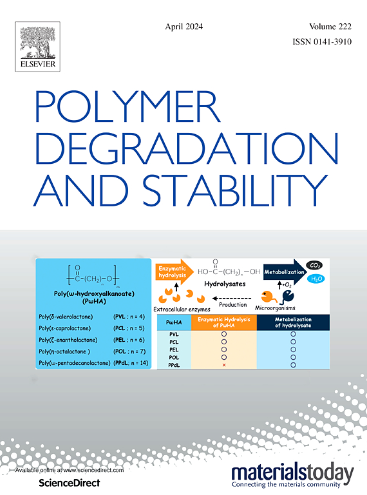Process study for high-purity BHET (bis(2-hydroxyethyl) terephthalate) production via microwave-assisted PET depolymerization
IF 7.4
2区 化学
Q1 POLYMER SCIENCE
引用次数: 0
Abstract
This study investigated the microwave-assisted glycolysis of polyethylene terephthalate (PET) using ethylene glycol (EG) to produce colorless bis(2-hydroxyethyl) terephthalate (BHET). Based on the Box-Behnken design combined with response surface methodology, the optimal reaction conditions were determined as follows: mass ratio of EG to PET (w(EG): w(PET)) of 4:1, catalyst dosage of 0.52 wt% relative to PET mass, microwave power of 720 W, and depolymerization duration of 42 min. Through morphological characterization of depolymerized products under microscopic observation, the purification process of BHET was optimized to prevent structural defects during crystallization. Under these optimized conditions, a BHET yield of 91.98 % was achieved. Compared with conventional heating methods, microwave irradiation significantly reduces the high-temperature residence time of the reaction, thereby effectively suppressing side reactions. This improvement results in marked enhancement of BHET chroma and enables its potential to produce PET.
微波辅助PET解聚制备高纯度对苯二甲酸双(2-羟乙基)对苯二甲酸乙酯的工艺研究
研究了用乙二醇(EG)对聚对苯二甲酸乙二醇酯(PET)进行微波辅助糖解法制备无色的二(2-羟乙基)对苯二甲酸乙二醇酯(BHET)。基于Box-Behnken设计结合响应面法,确定了最佳反应条件:EG与PET的质量比(w(EG): w(PET))为4:1,催化剂用量相对于PET质量为0.52 wt%,微波功率为720 w,解聚时间为42 min。通过显微镜观察解聚产物的形态表征,优化了BHET的纯化工艺,避免了结晶过程中的结构缺陷。在此优化条件下,BHET收率为91.98%。与传统的加热方法相比,微波辐照显著缩短了反应的高温停留时间,从而有效抑制了副反应。这一改进显著提高了BHET的色度,并使其具有生产PET的潜力。
本文章由计算机程序翻译,如有差异,请以英文原文为准。
求助全文
约1分钟内获得全文
求助全文
来源期刊

Polymer Degradation and Stability
化学-高分子科学
CiteScore
10.10
自引率
10.20%
发文量
325
审稿时长
23 days
期刊介绍:
Polymer Degradation and Stability deals with the degradation reactions and their control which are a major preoccupation of practitioners of the many and diverse aspects of modern polymer technology.
Deteriorative reactions occur during processing, when polymers are subjected to heat, oxygen and mechanical stress, and during the useful life of the materials when oxygen and sunlight are the most important degradative agencies. In more specialised applications, degradation may be induced by high energy radiation, ozone, atmospheric pollutants, mechanical stress, biological action, hydrolysis and many other influences. The mechanisms of these reactions and stabilisation processes must be understood if the technology and application of polymers are to continue to advance. The reporting of investigations of this kind is therefore a major function of this journal.
However there are also new developments in polymer technology in which degradation processes find positive applications. For example, photodegradable plastics are now available, the recycling of polymeric products will become increasingly important, degradation and combustion studies are involved in the definition of the fire hazards which are associated with polymeric materials and the microelectronics industry is vitally dependent upon polymer degradation in the manufacture of its circuitry. Polymer properties may also be improved by processes like curing and grafting, the chemistry of which can be closely related to that which causes physical deterioration in other circumstances.
 求助内容:
求助内容: 应助结果提醒方式:
应助结果提醒方式:


